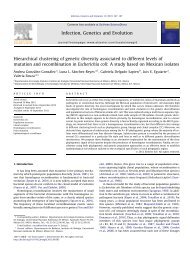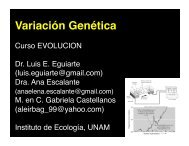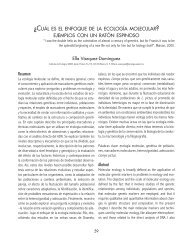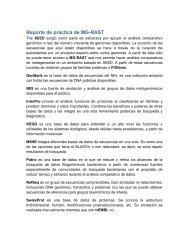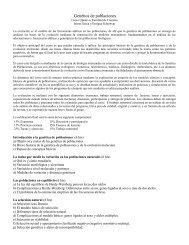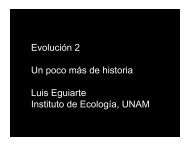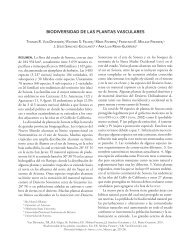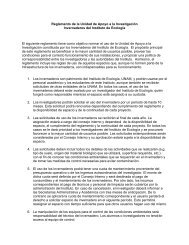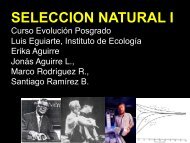4VariacionEvolucion2b copy.pdf - Instituto de Ecología
4VariacionEvolucion2b copy.pdf - Instituto de Ecología
4VariacionEvolucion2b copy.pdf - Instituto de Ecología
- No tags were found...
Create successful ePaper yourself
Turn your PDF publications into a flip-book with our unique Google optimized e-Paper software.
Genetic signals of origin, spread, and introgression ina large sample of maize landracesJoost van Heerwaar<strong>de</strong>n a,1 , John Doebley b , William H. Briggs c , Jeffrey C. Glaubitz d , Major M. Goodman e , Jose <strong>de</strong> JesusSanchez Gonzalez f , and Jeffrey Ross-Ibarra a,1a Department of Plant Sciences, University of California, Davis, CA 95616; b Department of Genetics, University of Wisconsin, Madison, WI 53706; c SyngentaSeeds, 1601 BK, Enkhuizen, The Netherlands; d Institute for Genomic Diversity, Cornell University, Ithaca, NY 14853; e Department of Crop Science, NorthCarolina State University, Raleigh, NC 27695; and f Centro Universitario <strong>de</strong> Ciencias Biológicas y Agropecuarias, Universidad <strong>de</strong> Guadalajara, Zapopan, JaliscoCP45110, MexicoPNAS January 18, 2011, vol. 108| no. 3: 1088–1092!!They genotyped a single plant from each of1,127 accessions of maize landraces, 100accessions of parviglumis, and 96 accessionsEdited by Dolores R. Piperno, Smithsonian National Museum of Natural History and Smithsonian Tropical Research Institute, Fairfax, VA, and approvedDecember 9, 2010 (received for review August 31, 2010)The last two <strong>de</strong>ca<strong>de</strong>s have seen important advances in ourknowledge of maize domestication, thanks in part to the contributionsof genetic data. Genetic studies have provi<strong>de</strong>d firmevi<strong>de</strong>nce that maize was domesticated from Balsas teosinte (Zeamays subspecies parviglumis), a wild relative that is en<strong>de</strong>mic tothe mid- to lowland regions of southwestern Mexico. An interestingparadox remains, however: Maize cultivars that are mostclosely related to Balsas teosinte are found mainly in the Mexicanhighlands where subspecies parviglumis does not grow. Geneticdata thus point to primary diffusion of domesticated maize fromthe of highlands mexicana.!rather than from the region of initial domestication.Recent archeological evi<strong>de</strong>nce for early lowland cultivation hasbeen consistent with the genetics of domestication, leaving theissue ! of the ancestral position of highland maize unresolved. Weused a new SNP dataset scored in a large number of accessions ofboth teosinte and maize to take a second look at the geography ofthe earliest cultivated maize. We found that gene flow betweenmaize and its wild relatives meaningfully impacts our inference of!geographic origins. By analyzing differentiation from inferred ancestralgene frequencies, we obtained results that are fully consistentwith current ecological, archeological, and genetic dataconcerning the geography of early maize cultivation.maize’s wild ancestor and the most ancestral maize population isparadoxical (5) and raises questions about how to reconcile thegenetic ancestry of mo<strong>de</strong>rn maize with the genetic and archeologicalevi<strong>de</strong>nce supporting domestication at lower altitu<strong>de</strong>s.Two explanations have been proposed for the ancestral positionof highland maize. First, parviglumis may have grown in thehighlands at the time of domestication (5, 11). Second, the earlydomesticate may have spread from the lowlands to the highlands,with a subsequent diffusion of highland maize replacing lowlandpopulations (11). Neither resolution is particularly satisfying:parviglumis probably grew at lower altitu<strong>de</strong>s during the coolerand dryer climatic conditions that likely existed around the timeof maize domestication (7, 12, 13), and the replacement hypothesisseems unlikely given the difference in ecological adaptationbetween highland and lowland maize (14).Some existing evi<strong>de</strong>nce suggests a third solution to the paradox.Maize in the Mexican highlands grows sympatrically with a secondsubspecies of annual teosinte, Zea mays subspecies mexicana(hereafter, mexicana). Maize and mexicana are interfertile (15),and there is evi<strong>de</strong>nce for gene flow from mexicana into maize(5, 16). Although not directly ancestral to maize, mexicana is moreclosely related to parviglumis than to maize (5), so gene flowSNPs were scored in 547 genes, 964 SNPs "



